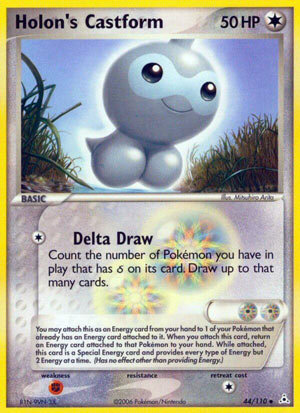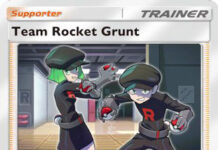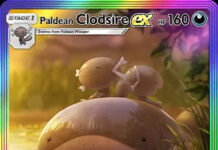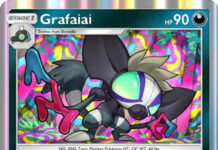
Holon’s Castform
– Holon Phantoms
Date Reviewed:
September 10, 2020
Ratings Summary:
Standard: N/A
Expanded: N/A
Limited: 3.25
Ratings are based on a 1 to 5 scale. 1 is horrible. 3 is average. 5 is great.
Reviews Below:
 Vince Now this (Holon’s Castform) and Holon’s Electrode/Magneton are the ones that I enjoyed using! For for the purpose of this review, I guess we’ll be looking at just Holon’s Castform. Like last week’s Magnemite and Voltorb, they are also basic Pokémon and also acts like a Special Energy card, though technically they are Pokémon and not categorized as Special Energy cards. Unlike last week’s cards, where it provides a single colorless energy, it actually provides Double Rainbow Energy (2 units of energy of any type) at the cost of returning an energy card from the Pokémon you’re about to attach Holon’s Castform to. This card would have to be compared with Double Rainbow Energy (the actual special energy card). For Double Rainbow Energy, it: -works only for Evolved Pokemon For Holon Castform, it -works for any Pokémon, but Not to mention other concerns of starting the game with Castform if that’s your only Basic Pokémon in your starting hand, missing out the vaunted Double Rainbow Energy effect. I’m trying to recall how well it did, and I guess it did saw play on decks that like to flood their energies on the board to amplify damage scaling attacks. I recall some Pokémon’s attacks require at least 2 different energy types like Team Rocket cards, so both DRE and Castform helped to some extent. If you have any Pokémon that provides unlimited energy acceleration, then Castform’s cost isn’t a cost at all! I used to have one copy of Holon’s Electrode and I think it would’ve been the better pick due to being a a Stage 1, which you don’t have to worry about starting with one. If it were to be in current standard/expanded format, it would greatly helped various Pokémon with multiple different energy types, especially those Amazing Rares that’s about to be released eventually. ratings: Standard: N/A (would be 3/5 if legal) Expanded: N/A (would be 3/5 as well) Limited: 2.5/5 (Only useful if you pulled other Delta Pokémon) |
 Otaku Continuing our theme from last week, our Throwback is Holon’s Castform (Holon Phantoms 44/110). We first reviewed it on April 24, 2006, then it received a re-review on January 4, 2007. I think you can guess what we’ll be looking at next Thursday, though perhaps you expected another double review today instead? Let’s start with the card’s name: the Holon region is exclusive to the Pokémon TCG; you can read up on it here. Weird stuff happens in Holon, justified in the lore by unusual natural phenomena combined with Pokémon research, and in the real-world by a desire to balance out the amount of Pokémon in each type, though that last bit is from my memory, not the Bulbapedia article. Either way, Pokémon δ originate from Holon, and are represented by the “wrong” TCG type. Some are even dual-typed. Between their name and HP, the card will read “δ Delta Specices”, but this is not part of the card’s name. “Holon’s” is distinct from both Pokémon δ and cards with “Holon” in their name e.g. none of the Holon’s Pokémon are Pokémon δ. There are several Trainers with just “Holon” (no “‘s” on the end), as well as a series of Special Energy cards. Collectively, the former are known as the “Holon Engine” or “Holon Trainer Engine” by players while the latter are referred to as “Holon Energy” by actual card text. The are “Holon’s” cards are:
“Holon’s” is part of these cards’ names, so for an effect to work with them it must name them specifically, or be worded to include all Pokémon with the right Pokémon specie in the name, like how Falinks’ “Team Attack” counts both Falinks and Falinks V, and Falinks V’s “Iron Defense Formation” Ability protects both Falinks and Falinks V. As far as the 4 Copy Rule, evolving, etc. Holon’s Castform is unrelated to other Castform cards (not that there is an evolution for Castform). Holon’s Castform is a Basic Pokémon, which makes it space efficient as easy to put into play. It can also act as your opening Active, which can be a real drawback for this card, as we’ll eventually see. 50 HP was a little low for a non-evolving Basic back then, and is… honestly, not as much lower as it should be if power creep were applied evenly across all Pokémon regardless of Stage, even adjusting for this being a single-Prize Pokémon. [F] Weakness was dangerous back then, just like now, and for almost the same reason: Fighting types tended to be good at fast, quick damage. It is just now they’re also good at stacking damage bonuses. No Resistance was and still is the worst, but both then and now, it hardly makes a difference. Another thing that hasn’t really changed is that a single Energy Retreat Cost is good; easy to pay and recover from having paid, most of the time. Holon’s Castform knows only one attack but it is one of the few cards with a non-attack effect that is also not an Ability, Ancient Trait, Held Item, Poké-Body, Poké-Power, Pokémon Power, or any other non-attack effect I may have missed. The attack is “Delta Draw”, and for [C] it had you count the number of Pokémon you have in play with “δ” on them, then draw that many cards. I was unable to locate an official ruling, but I believe it did not include itself. Taking the English text literally means that it would, but remember this is a TCG, so you should use a straightforward reading that acknowledges how the game works. The “δ Delta Species” label is not part of a card’s name, Stage, or anything with a convenient term with which to refer to it, so they mentioned it on its card. This kind of attack was far better back in the day; it was still somewhat common for a deck to use its first attack or two on setting up, and you could still attack Turn 1. Even drawing three cards was an acceptable return, and if you had five Pokémon δ on your Bench, drawing five cards was amazing! Still, all of that was just a bonus (or sometimes a drawback); the card’s other effect was the real deal. As with the other cards that have “Holon’s” in their name, you could opt to play Holon’s Castform as an Energy card from your hand. Yes, this used up your manual Energy attachment for the turn, you could not drop more than one of these in a single turn, unless you had an effect that gave you an extra from-the-hand attachment and worked with Special Energy cards. From the moment you choose to use this effect, until the moment Holon’s Castform leaves the field, it would then count as a Special Energy. Unlike Holon’s Magnemite or Holon’s Voltorb – we looked at both last week – there’s a catch. Holon’s Castform may only be attached to a Pokémon that already has at least one Energy attached to it, and that is because you attach Holon’s Castform and then immediately return a different Energy attached to that Pokémon to your hand! What could be worth that kind of drawback? Holon’s Castform provides two units of Energy which each count as all types while attached to one of your Pokémon! No, you’re not ahead in terms of the number of Energy you have attached, but you’ve got ultimate quality. Well, unless you had to bounce a Special Energy that had an ongoing effect you wanted to keep. If it had a one-and-done effect, though, you have a chance to reuse what you bounced, if it had an ongoing effect you actually wanted to get rid of, it was now gone. If it was just a regular basic Energy… well, it had still been replaced by something that could meet any cost that didn’t specify “basic Energy”. This is also where being a Basic Pokémon could be a drawback; if you wanted to open with Delta Draw, it wasn’t a problem, but if you didn’t (like when you weren’t running any Pokémon δ), it was a waste of a Holon’s Castform. Some of you may still be a bit skeptical, because having to return an Energy to hand, especially from the Pokémon to which you’re attaching Holon’s Castform, is a very significant cost. I’ll use an example with a modern card to help. Say you had two basic Fire Energy cards in hand, along with Welder. You use Welder and attach the two Fire Energy to one of your Pokémon. Then, whether you drew into Holon’s Castform or had it in hand all along, you now use your manual Energy attachment to bounce one of those two basic Fire Energy cards back to your hand, but the target Pokémon goes from having [RR] attached to [@@R], where “@” was the old shorthand for a unit of rainbow (all types) Energy. So any attack that costs [CCC], [RRR], or two non-[C] Energy plus either one unit of [C] or [R] are ready to be used! We didn’t have Welder back in the day, but we had other Energy accelerators, significantly reducing or effectively eliminating the drawback to this card. Some of you who know the cardpool from this time may be thinking “Why not just use Double Rainbow Energy or Scramble Energy?” Double Rainbow Energy could only be attached to non-Pokémon-ex evolved Pokémon, and discarded itself if it somehow made its way onto a Basic Pokémon. It also reduced the damage of that Pokémon’s attacks by 10 before Weakness and Resistance. The damage reduction was cumulative; two Double Rainbow Energy meant -20 damage, three -30, and four -40 damage. Scramble Energy was almost the same, but instead of reducing damage done, it provided only [C] Energy unless you had more Prize cards remaining than your opponent, at which point it provided three units of Energy that each counted as all types at once. Some decks ran all three, but those focused on powering up Basic Pokémon and/or Pokémon-ex favored Holon’s Castform, Holon’s Electrode, and/or Holon’s Magneton. Yes, those other two had the same effect as Holon’s Castform, but we’ll be discussing them next week so I won’t be going into more detail. The following World Championship decks included Holon’s Castform:
However, I’m also going to list decks that ran Holon’s Electrode and/or Holon’s Magneton, given how similar the functionality was:
This is not to say the cards were completely interchangeable, but I am saying that these cards were primarily used for the same used-as-Special-Energy effect. If you don’t think that should “count”… there’s still the three actual uses of Holon’s Castform in World Championship decks. For the Limited Format, I’m assuming this was a powerful pull; maybe not a literal “must run”, but most decks would appreciate it for its effect, and some for its attack. Remember, this card predates the existence of basic Darkness Energy and Metal Energy… What if Holon’s Castform were reprinted? It wouldn’t be for every deck, but I think a decent amount would either fine a use for it, or spring up around it. Delta Draw would probably prevent a straight-up reprint, however, given we have no Pokémon δ with which it would work. Even if we did, opening draw attacks aren’t anywhere near as good as they used to be. That effect, though… there’s a reason I used Welder. Think of what Holon’s Castform would mean for Welder decks; Welder can attach basic Fire Energy to Pokémon of any type, and has no restrictions with regards to other game mechanics. Most three Energy attacks would be available with a single turn of prep, and bouncing a basic Fire Energy back into hand just makes it easier to use a copy of Welder on your next turn! It might reinvigorate Mewtwo & Mew-EX for similar reasons. Even without Welder, you’ve got Metal Saucer in Metal decks, Turbo Patch for anything Basic that is not a Pokémon-GX, etc. Ratings
With Holon’s Castform done, we’ve now looked at 60% of the Holon’s cards. I really do like how this card isn’t your traditional Energy acceleration; it’s about quality and not quantity, though it was often run with Energy acceleration to combo into both! I’d love to see something based on this return… except that I don’t think I’d want the “Play as Energy” effect to be some nameless mechanic. Sure, it is nice nothing (currently) counters such things specifically, while an Ability that did this would have to deal with Ability denial… but I like that Abilities aren’t guaranteed. |
We would love more volunteers to help us with our Card of the Day reviews. If you want to share your ideas on cards with other fans, feel free to drop us an email. We’d be happy to link back to your blog / YouTube Channel / etc. 😉
Click here to read our Pokémon Card of the Day Archive. We have reviewed more than 3500 Pokemon cards over the last 17+ years!



